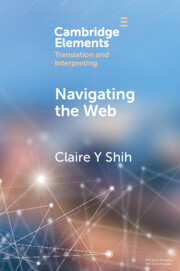61 results
Challenges in inflected word processing for L2 speakers: The role of stem allomorphy
-
- Journal:
- Studies in Second Language Acquisition , First View
- Published online by Cambridge University Press:
- 11 February 2025, pp. 1-28
-
- Article
-
- You have access
- Open access
- HTML
- Export citation
Relative contributions of predictive vs. associative processes to infant looking behavior during language comprehension
-
- Journal:
- Journal of Child Language , First View
- Published online by Cambridge University Press:
- 10 February 2025, pp. 1-24
-
- Article
-
- You have access
- Open access
- HTML
- Export citation
Estimating the dynamic role of attention via random utility
-
- Journal:
- Journal of the Economic Science Association / Volume 5 / Issue 1 / August 2019
- Published online by Cambridge University Press:
- 17 January 2025, pp. 97-111
-
- Article
- Export citation
Eye-tracking and economic theories of choice under risk
-
- Journal:
- Journal of the Economic Science Association / Volume 5 / Issue 1 / August 2019
- Published online by Cambridge University Press:
- 17 January 2025, pp. 26-37
-
- Article
- Export citation
Do people exploit risk–reward structures to simplify information processing in risky choice?
-
- Journal:
- Journal of the Economic Science Association / Volume 5 / Issue 1 / August 2019
- Published online by Cambridge University Press:
- 17 January 2025, pp. 76-94
-
- Article
-
- You have access
- Open access
- HTML
- Export citation
The effect of context on the processing and learning of novel L2 vocabulary while reading
-
- Journal:
- Applied Psycholinguistics / Volume 45 / Issue 6 / November 2024
- Published online by Cambridge University Press:
- 06 January 2025, pp. 1086-1113
-
- Article
-
- You have access
- Open access
- HTML
- Export citation
Better Information From Survey Data: Filtering Out State Dependence Using Eye-Tracking Data
-
- Journal:
- Psychometrika / Volume 87 / Issue 2 / June 2022
- Published online by Cambridge University Press:
- 01 January 2025, pp. 620-665
-
- Article
- Export citation
An empirical study on native Mandarin-speaking children’s metonymy comprehension development
-
- Journal:
- Journal of Child Language , First View
- Published online by Cambridge University Press:
- 13 December 2024, pp. 1-28
-
- Article
-
- You have access
- Open access
- HTML
- Export citation
Investigating the Uniform Information Density hypothesis with complex nominal compounds
-
- Journal:
- Applied Psycholinguistics / Volume 45 / Issue 2 / March 2024
- Published online by Cambridge University Press:
- 12 April 2024, pp. 322-367
-
- Article
-
- You have access
- HTML
- Export citation
Chapter 4 - Skilled Reading
-
- Book:
- The Psychology of Reading
- Published online:
- 04 January 2024
- Print publication:
- 18 January 2024, pp 90-128
-
- Chapter
- Export citation
Comprehension and processing of the universal quantifier in children, adolescents and adults
-
- Journal:
- Journal of Child Language / Volume 52 / Issue 1 / January 2025
- Published online by Cambridge University Press:
- 03 November 2023, pp. 96-116
-
- Article
-
- You have access
- Open access
- HTML
- Export citation
The predictive processing of number information in subregular verb morphology in a first and second language
-
- Journal:
- Applied Psycholinguistics / Volume 44 / Issue 5 / September 2023
- Published online by Cambridge University Press:
- 08 May 2023, pp. 750-783
-
- Article
-
- You have access
- Open access
- HTML
- Export citation

Navigating the Web
- A Qualitative Eye Tracking–Based Study of Translators' Web Search Behaviour
-
- Published online:
- 03 April 2023
- Print publication:
- 13 April 2023
-
- Element
- Export citation
Predicting processing effort during L1 and L2 reading: The relationship between text linguistic features and eye movements
-
- Journal:
- Bilingualism: Language and Cognition / Volume 26 / Issue 4 / August 2023
- Published online by Cambridge University Press:
- 06 February 2023, pp. 724-737
-
- Article
- Export citation
6 - Subjunctive Mood
-
- Book:
- Second Language Acquisition
- Published online:
- 03 February 2023
- Print publication:
- 26 January 2023, pp 153-193
-
- Chapter
- Export citation
10 - Where to Go Next
-
- Book:
- Second Language Acquisition
- Published online:
- 03 February 2023
- Print publication:
- 26 January 2023, pp 301-324
-
- Chapter
- Export citation
Identifying decision strategies in a consumer choice situation
-
- Journal:
- Judgment and Decision Making / Volume 3 / Issue 8 / December 2008
- Published online by Cambridge University Press:
- 01 January 2023, pp. 641-658
-
- Article
-
- You have access
- Open access
- HTML
- Export citation
Focusing on what you own: Biased information uptake due to ownership
-
- Journal:
- Judgment and Decision Making / Volume 7 / Issue 3 / May 2012
- Published online by Cambridge University Press:
- 01 January 2023, pp. 254-267
-
- Article
-
- You have access
- Open access
- HTML
- Export citation
Learning affects top down and bottom up modulation of eye movements in decision making
-
- Journal:
- Judgment and Decision Making / Volume 8 / Issue 6 / November 2013
- Published online by Cambridge University Press:
- 01 January 2023, pp. 700-716
-
- Article
-
- You have access
- Open access
- HTML
- Export citation


